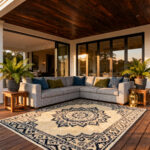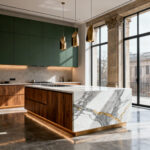I vividly recall a project installation at a client’s coastal estate where the design finally clicked into place. We stood on the veranda as the sun dipped below the horizon, watching a gentle breeze catch the sheer linen drapery while the last rays of sunlight ignited the crystal stemware on the side table. In that fleeting moment, the home did not just shelter us; it breathed. This profound connection is the essence of the “Twilight Salon.” It is not merely a back porch; it is a curated destination where the energy of the day decompresses into the elegance of the night. Achieving superior back porch decorating requires vision, planning, and attention to tactile detail.
Too many homeowners treat their outdoor spaces as utilitarian afterthoughts, relying on harsh security floodlights and uninspired, weather-beaten plastics. True sophistication requires a deliberate shift in perspective. We must treat the exterior lounge with the same reverence and attention to detail as a formal interior living room. By establishing boundaries with architectural elements and introducing seamless indoor-outdoor flow, you transform a simple deck into an extension of your home’s soul. The goal is to create a soft sense of enclosure that invites lingering conversation long after dusk.
In this guide, we will dissect the anatomy of this high-end aesthetic. We will move beyond basic patio furniture to discuss the nuances of layered, warm lighting and the strategic use of reflective finishes to capture the evening glow. You will discover how to select durable, investment-grade textiles that mimic the plush comfort of indoor velvet and silk. Let us curate a sanctuary that maximizes your square footage and elevates your evening ritual. It is time to design a space where every sunset feels like a private viewing.
The Philosophy of Extension: Mastering Luxury Back Porch Decorating
Treat the back porch as the summer’s primary drawing room, not a casual appendage. In my design practice, I insist on erasing the psychological threshold between indoors and out by prioritizing seamless continuity. Carry your interior color palette outward and bridge the flooring gap with high-quality rugs that echo your indoor aesthetic. Furthermore, reject the stiffness of standard patio sets. Instead, invest in deep-seated, fully upholstered sectionals clad in premium performance fabrics. These modern textiles now rival the hand-feel of interior linens, ensuring your outdoor living space commands the same respect—and comfort—as the main parlor.
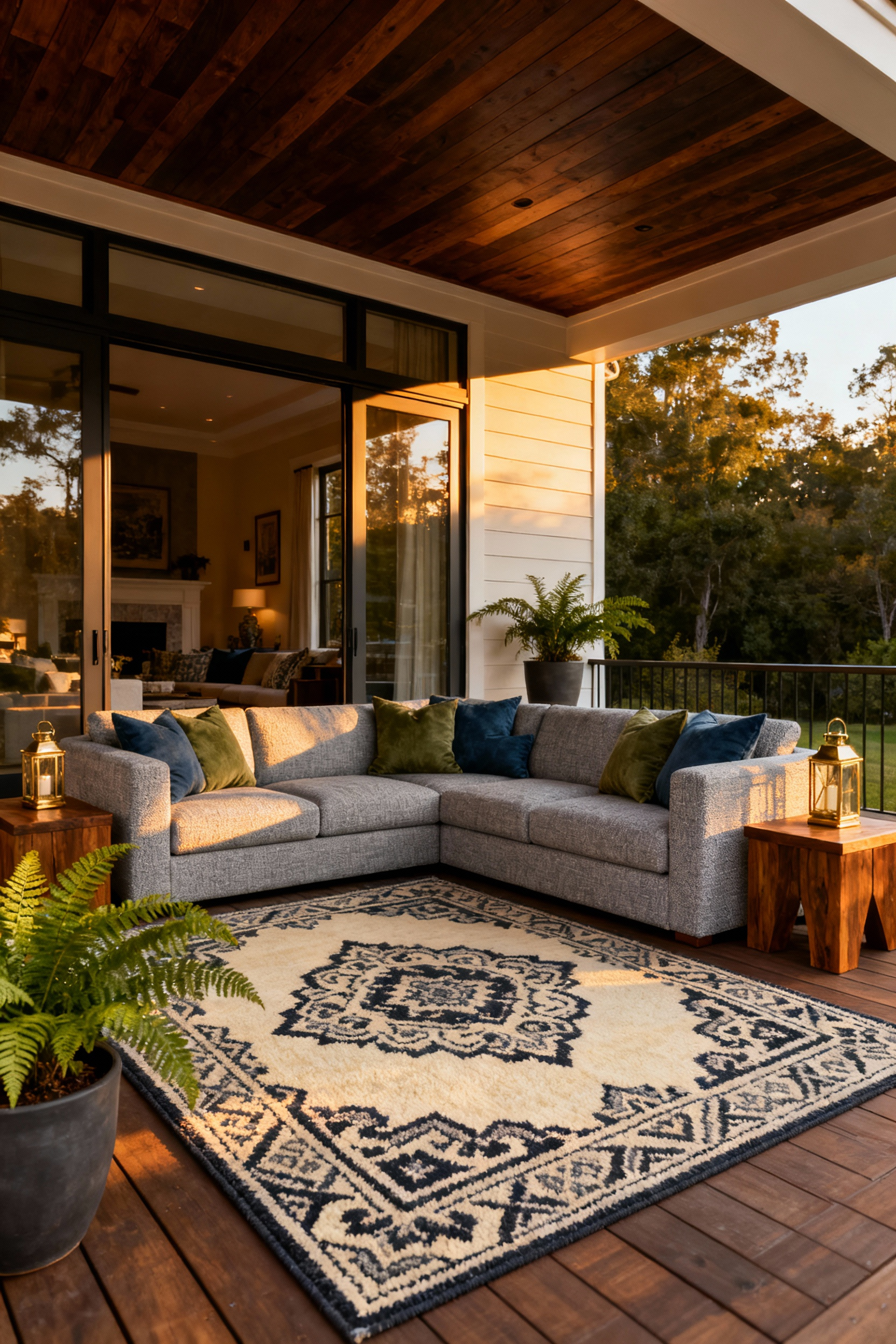
Once the foundation is set, layer the environment with the refined details typically reserved for interiors. To achieve a truly high-end finish:
- Establish Architecture: Use large, sculptural foliage like agave to frame the perimeter, creating permanent structure rather than temporary decoration.
- Curate Ambiance: Install a statement chandelier or floor lamps to replace harsh security lighting.
- Ensure Utility: Incorporate a ceiling fan for midday heat and a fire feature to extend the room’s life into autumn.
By treating this square footage with the same rigor as your living room, you maximize the return on your property’s most undervalued asset.
I. The Architectural Envelope: Establishing the Foundation
True luxury begins with an unshakeable foundation. In my years curating spaces for discerning clients, I have found that even the most expensive furnishings cannot mask a poor architectural envelope. Start with the flooring, as it grounds the entire aesthetic. Select composite decking or sealed stone tile for a surface that defies age and weather. Insist on rot-resistant structural materials, such as Western Red Cedar, for your framing. This investment in quality craftsmanship ensures your porch remains a timeless asset rather than a maintenance burden.
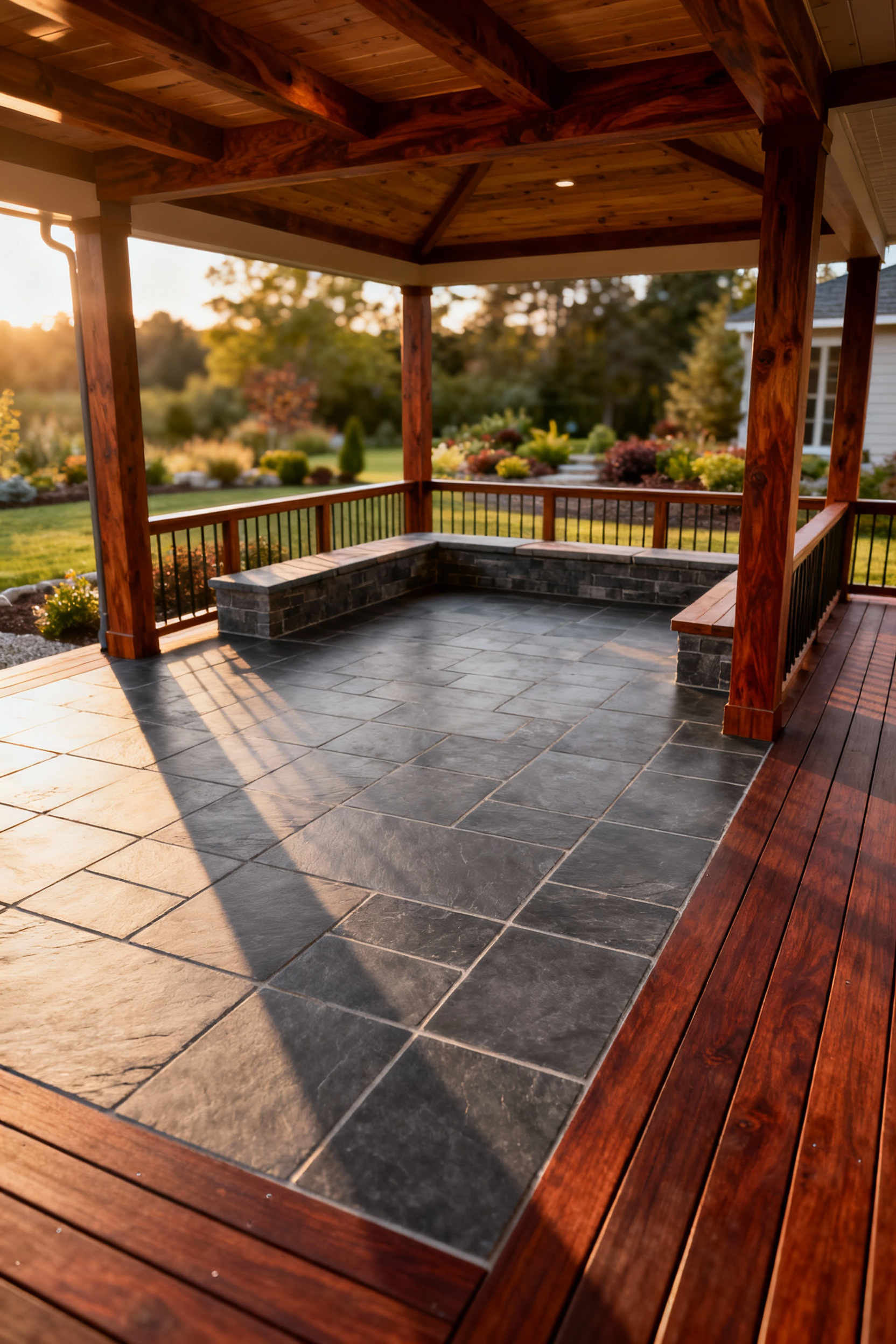
Once the base is secure, design the enclosure to manage the flow of light and air. View your roof and railings not merely as compliance with safety codes, but as the refined finish of the envelope. To elevate the structure, consider these functional upgrades:
- Roofing: Install a repurposed tin ceiling or clear panels to protect investments while amplifying natural light.
- Railings: Utilize cable systems or glass panels to maintain unobstructed views of the landscape.
- Weather Management: Plan deep overhangs to shield against harsh elements.
By prioritizing these structural elements now, you create a refined, weather-protected “outdoor room” ready for sophisticated living.
1. Dissolving the Threshold: Selecting flooring materials that create a seamless visual continuity from the interior parlor to the exterior loggia.
Architectural elegance dissolves the boundary between the parlor and the loggia. To create this singular, expanded volume, specify materials like porcelain tile or natural stone that transcend the glass line. I often advise clients to use the same stone slab throughout, shifting from a smooth interior hone to a textured, slip-resistant exterior finish for safety. The eye perceives no interruption, and the room feels infinite.
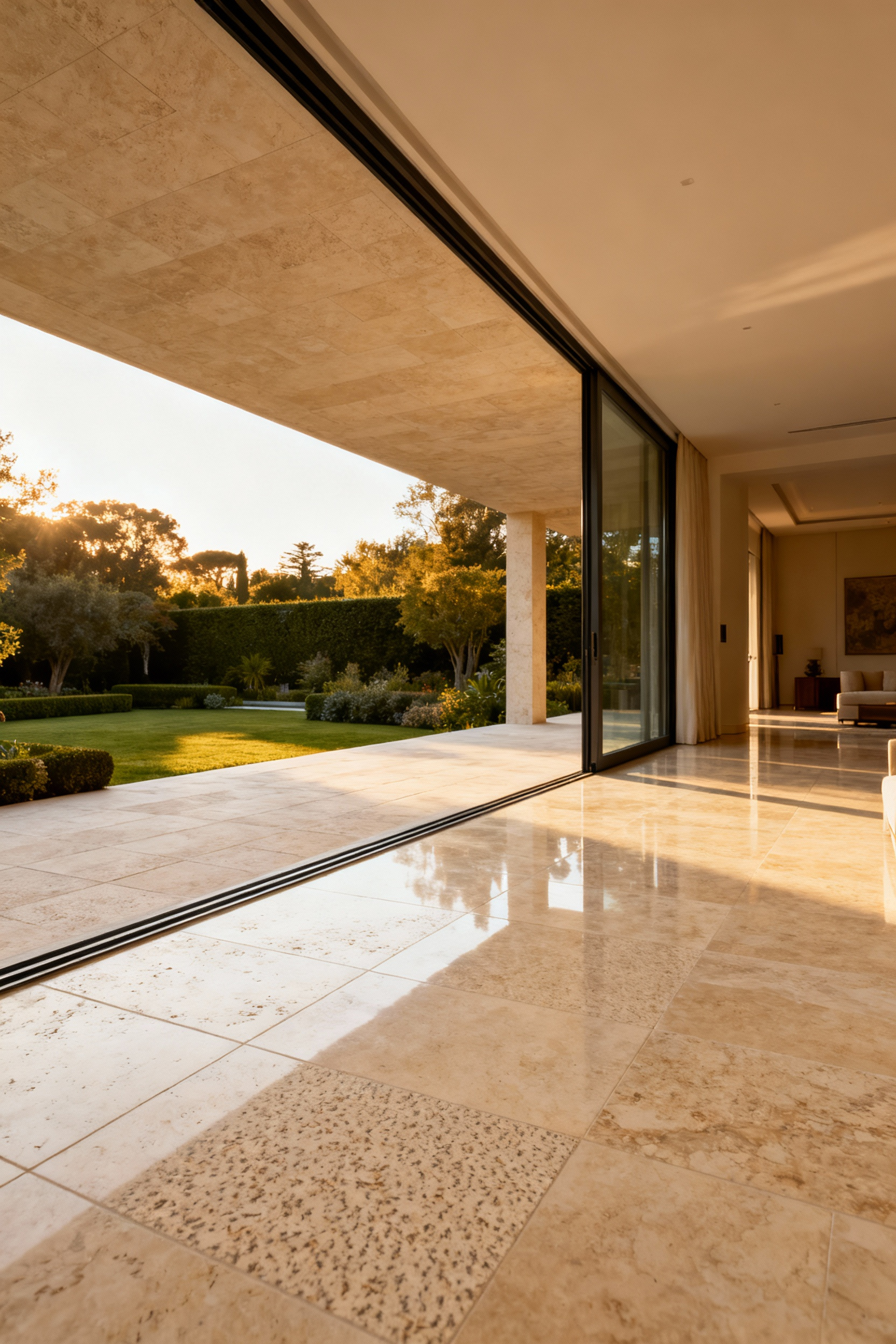
However, material selection fails without precise engineering. You must align the subfloors to sit on the exact same plane, utilizing recessed door tracks to eliminate the physical stumble of a traditional threshold. Strict attention to layout dictates the visual flow:
- Orient planks or tiles in the same direction to guide the eye outward.
- Use large-format sizes to minimize distracting grout lines.
- Match color tones meticulously if structural needs require different materials (e.g., interior oak paired with composite decking).
Consistency defines luxury. By maintaining the line of sight, you effectively borrow square footage from the outdoors.
2. The Fifth Wall: Elevating the porch ceiling with beadboard, coffered details, or custom millwork to mirror indoor sophistication.
Treat your porch ceiling with the same architectural rigor as your formal living room. Designers often refer to this surface as the “fifth wall.” To mimic indoor sophistication, install custom beadboard or deep coffered details that create immediate visual depth. Prioritize longevity over tradition; in my experience sourcing materials for coastal estates, natural wood eventually succumbs to humidity. Therefore, specify fiber cement or poly-ash composites for your millwork. These advanced materials capture the warmth of timber but resist rot, warping, and insects, ensuring your investment remains pristine for decades.

Once the structure is set, layer lighting and color to define the mood. A flat, unadorned ceiling feels unfinished; custom millwork provides a canvas for strategic illumination. To achieve a polished, high-end aesthetic:
- Hide flush-mounted recessed LEDs inside coffered beams for a clean, architectural glow.
- Anchor the seating area with a dramatic, damp-rated chandelier or large pendant.
- Paint the finish a crisp white to visually lift the ceiling and mirror interior elegance.
This attention to detail transforms a basic overhang into a luxurious, enduring extension of your home.
3. Structural Drapery: Utilizing heavy-weight outdoor curtains to frame views and create the intimacy of an enclosed room.
Elevate your outdoor living area by treating drapery as architecture rather than mere decoration. In my years designing luxury interiors, I have found that flimsy fabrics inevitably cheapen a space. Instead, select heavy-weight materials like marine-grade acrylic or thick canvas with a density of at least 800g/m. This substantial weight mimics the rich hand of indoor velvet while providing crucial thermal insulation. This ensures the fabric hangs with a tailored precision that defies the elements, transforming an open porch into a sophisticated, enclosed room.

To achieve this permanent look, installation technique is paramount. Mount your upper hardware directly against the ceiling line to draw the eye upward and maximize the illusion of height. Furthermore, position panels at the corners to deliberately frame your view. For true structural integrity, I always recommend a dual-rod system to my clients:
- Install a primary rod at the roofline.
- Secure a second rust-resistant rod a few inches above the floor.
- Anchor the curtain’s bottom grommets to this lower rail.
This method creates a taut, wall-like surface that prevents billowing, solidifying the intimacy of your sanctuary.
II. Materiality and Texture: The Tactile Experience
Refined design extends beyond the visual; it demands tactile engagement. In my years curating high-end residential terraces, I have observed that a flat, one-dimensional space never feels truly expensive. To achieve a sophisticated aesthetic, you must master the art of layering. Juxtapose sleek, cool metal frames against the coarse, organic grain of a hand-hewn stone side table. This intentional friction between smooth and rough surfaces creates depth. Embrace raw materials like travertine or distressed wood to ground the design, giving your porch an authentic, established weight that synthetic alternatives simply cannot replicate.

Furthermore, you must counteract the inherent rigidity of outdoor furniture. Metal and teak provide structure, but they require plush countermeasures to invite genuine relaxation. Invest in premium performance textiles that mimic the hand of indoor fabrics while withstanding the elements. Consider these essential adjustments to soften the architecture:
- Anchor the foundation: Lay a woven indoor/outdoor rug to define the conversation zone and provide a forgiving texture under bare feet.
- Prioritize loft: Pile on throw pillows encased in solution-dyed acrylics, such as Sunbrella, which resist fading yet offer a velvet-like touch.
- Introduce warmth: Incorporate rattan or wicker accents to instantly disrupt heavy masonry with an airy, woven quality.
These tactile choices transform a stark patio into a distinct, inviting destination.
4. The Foundation Rug: Moving beyond basic polypropylene to source hand-woven performance textiles that mimic the hand of wool.
Luxury resides in the hand, not just the eye. In my years of sourcing for private residences, I have consistently steered clients away from shiny, machine-made polypropylene toward materials that invite barefoot living. Elevate your porch’s foundation by selecting hand-woven rugs crafted from Recycled PET. This innovative fiber miraculously mimics the plush, chunky texture of premium wool while retaining industrial-grade durability.
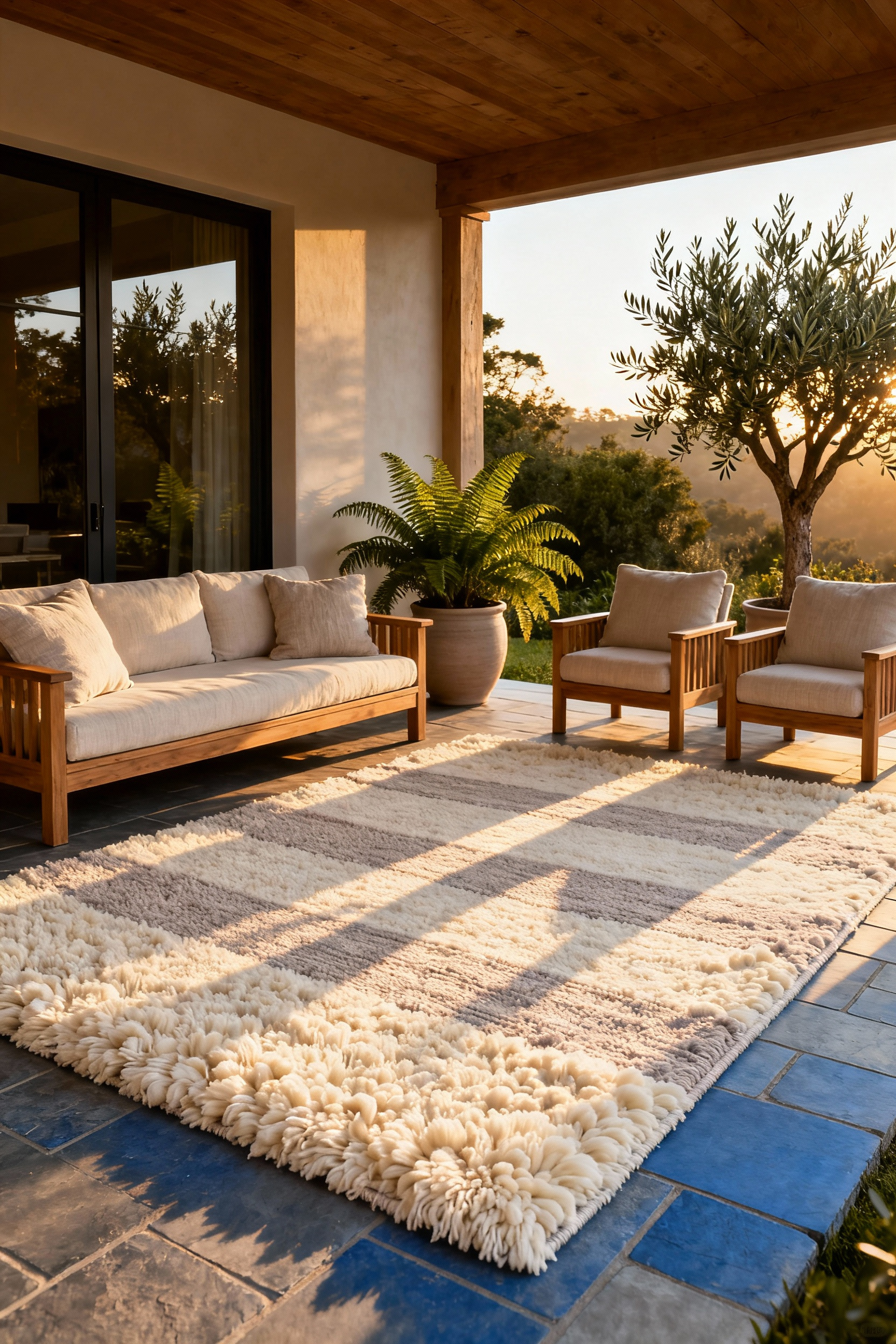
To identify a rug that truly bridges the indoor-outdoor gap, look for these specific markers of quality:
- Artisanal Construction: Choose flatweaves that offer the sophisticated finish of a fine indoor kilim.
- Natural Tones: Opt for heathered linen or charcoal hues to let the weave’s texture, rather than a loud pattern, serve as the design focus.
- Practical Maintenance: Verify that the piece is mold-resistant and capable of a simple hose-off cleaning.
Consequently, you secure a foundation that feels permanent rather than disposable. This material upgrade allows you to treat your back porch with the same design integrity and comfort as your formal living room.
5. Textile Sophistication: Incorporating unexpected fabrics like performance velvets and linens to soften the hard architectural edges.
Sophistication often lies in an unexpected juxtaposition of textures. In my years designing bespoke spaces, I have found that nothing softens the rigid geometry of a back porch better than the interplay of performance velvet and linen. Rather than defaulting to flat, standard canvas, layer the light-catching sheen of velvet against the organic, breathable drape of linen. This tactile contrast immediately disrupts hard architectural lines, adding depth and warmth to the structure.

However, aesthetics must never compromise durability. Strictly specify “High-Performance” or “Outdoor” grades to ensure UV stability and mildew resistance; without these technical properties, your investment will deteriorate. Apply the heavier velvet to seat cushions to ground the furniture visually, then use linen for drapes to introduce airy movement. Finally, protect your assets by blotting spills instantly and covering pieces during severe weather. This disciplined approach ensures your outdoor room maintains the refined elegance of a high-end interior.
6. Patina and Provenance: Integrating antique ironwork or weathered stone tables to add historical weight to new construction.
New construction frequently lacks soul. To remedy this sterility, introduce a single, substantial antique to serve as your visual anchor. I often advise clients to view a weathered stone table or a panel of salvaged wrought iron not as furniture, but as art. The rugged texture of these materials provides a necessary counterpoint to the crisp, clean lines of modern architecture. Consequently, the space feels established rather than manufactured. Authentic design relies on this tension between the pristine and the patinated.

Select materials that withstand the elements and age gracefully. When sourcing items for a curated back porch, prioritize durability alongside aesthetics:
- Heavily weathered iron: Use large gate sections as wall sculpture to break up blank siding.
- Moss-stained stone: Position garden urns or plinths near sleek, modern railings for high contrast.
- Salvaged hardwoods: Incorporate reclaimed timber for tables to add warmth.
By strategically placing these “found” objects next to contemporary seating, you highlight their historical weight. This intentional juxtaposition transforms a simple outdoor area into a sophisticated, timeless retreat.
7. Mixed Material Palettes: Balancing the warmth of teak or mahogany with the coolness of marble and brass accents.
A refined aesthetic relies on the tension between textures. Anchor your back porch with substantial teak or mahogany furniture to establish a warm, distinctively traditional foundation. In my early years in luxury retail, I learned that discerning clients avoid matching sets; instead, they curate a dialogue between materials. Use the wood’s rich grain to ground the space, then deliberately introduce marble and brass to inject sophisticated coolness. Treat these cooler elements like fine jewelry:
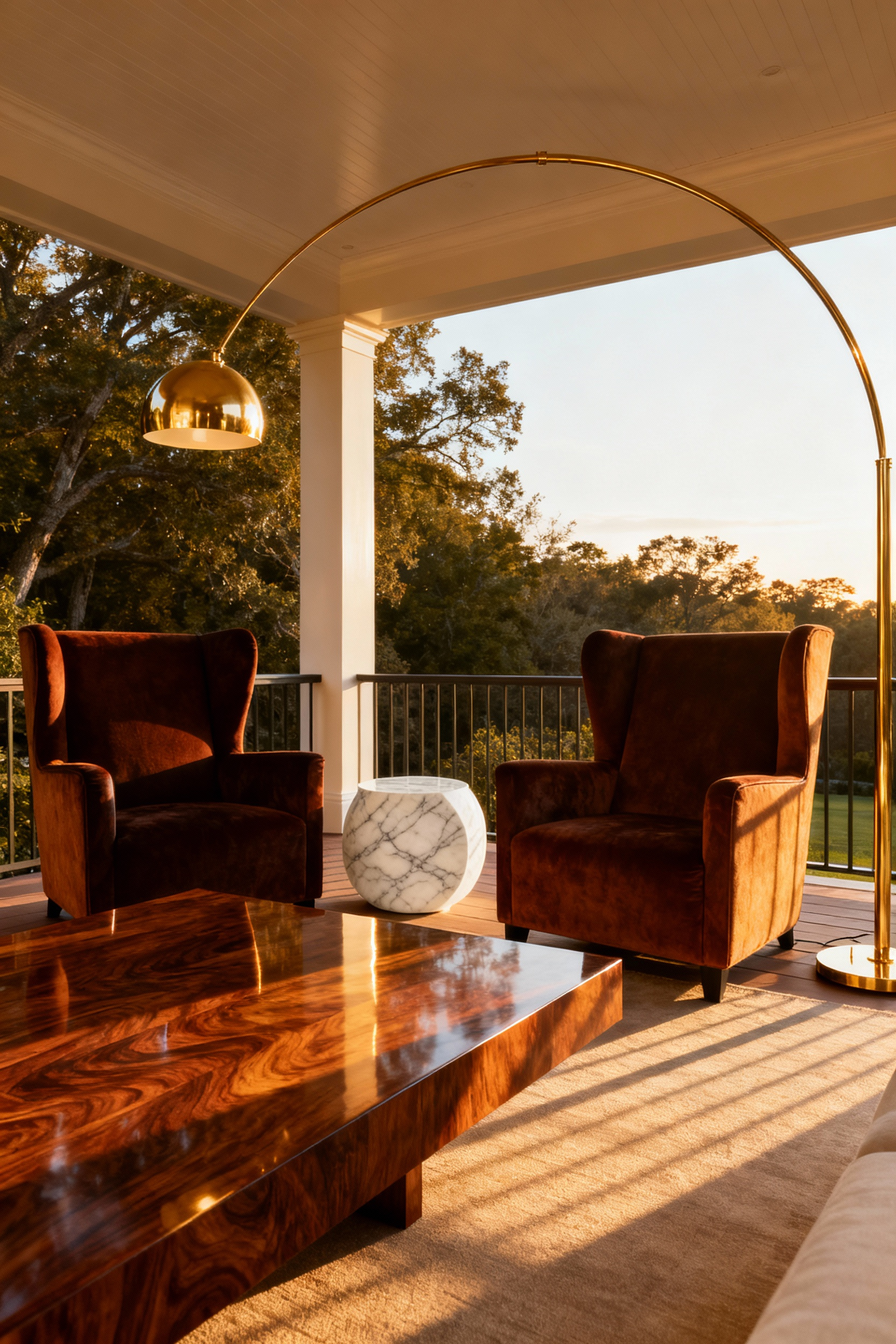
- Lighting: Install unlacquered brass sconces or pendants that develop a rich, living patina over time.
- Surfaces: Place a heavy, honed marble side table next to a timber chaise for immediate tactile contrast.
- Textiles: Bridge the visual gap with creamy, nubby wool throws or a textured sisal rug.
Finally, soften the transition between the organic wood and polished stone with vibrant greenery. Large potted ferns provide a necessary fresh foil to the hard surfaces, preventing the aesthetic from feeling too stark or museum-like.
III. Spatial Application: Lighting and Zoning
With materials selected, we must address how the space is perceived at night. Treat your back porch with the same architectural reverence as your indoor living quarters. In my years designing high-end residential spaces, I have found that lighting—not furniture—defines a room’s true boundaries. Establish distinct zones by varying fixture styles to narrate the function of each area. Anchor a dining table with a substantial outdoor chandelier to create a focal point, then transition to subtle wall sconces in the lounge area to cultivate intimacy. This visual separation creates depth, preventing the space from feeling like a flat, undefined slab of concrete.
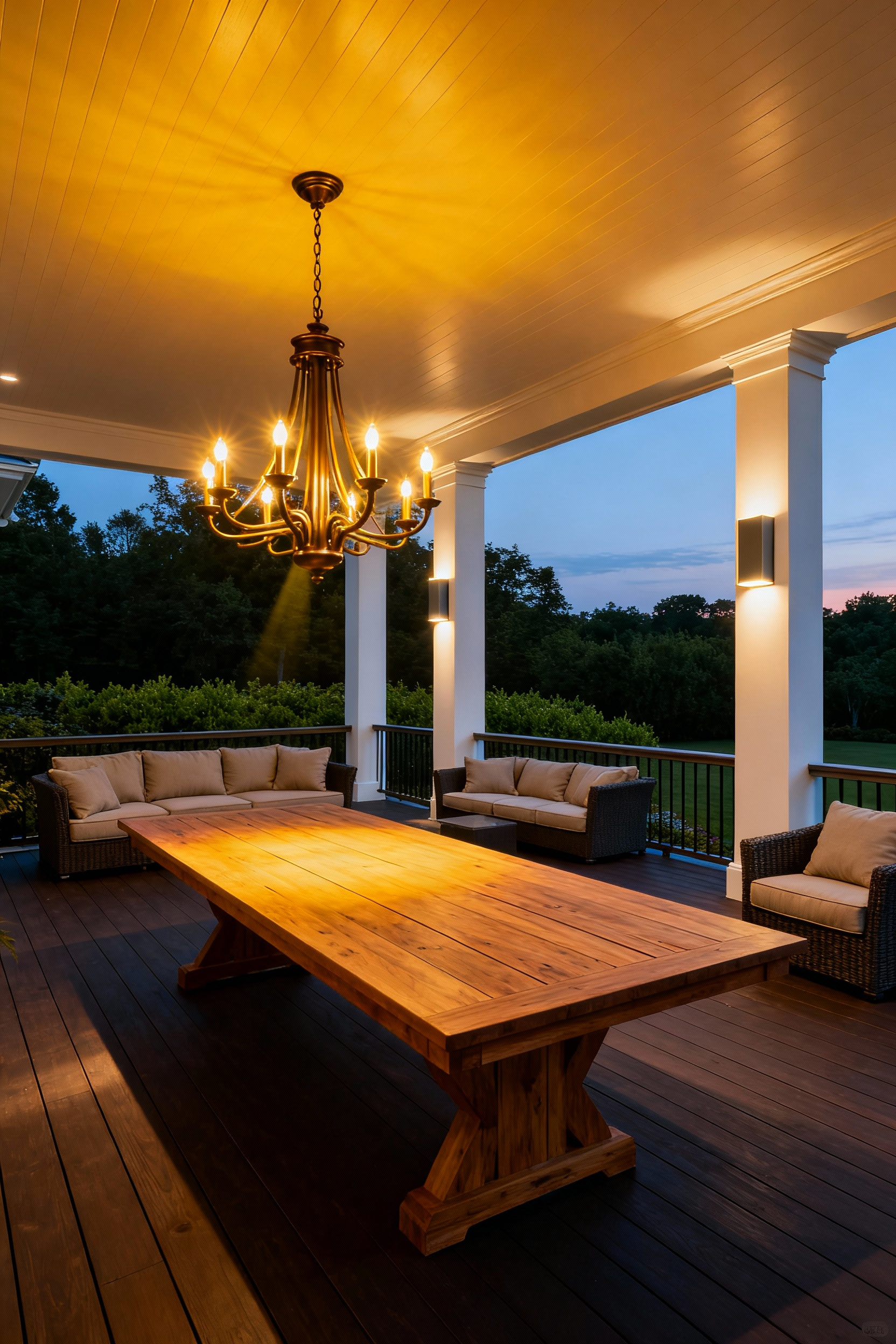
Beyond fixture selection, mastery of atmosphere requires precise technical layering. Avoid the harsh glare of standard security floods; instead, curate a flexible lighting plan that mimics the complexity of an interior scheme:
- Ambient: Provide general overhead glow using recessed cans or ceiling fans.
- Task: Install focused, brighter illumination over specific work areas, such as the grill.
- Accent: Utilize string lights or architectural uplighting to highlight texture and create mood.
Finally, insist on warm white bulbs between 2700K and 3000K to replicate the inviting glow of candlelight. Pair these with smart dimmers to control each zone independently, allowing you to shift effortlessly from the brilliance required for dining to the subdued elegance needed for evening cocktails.
8. Lighting Layering I (The Statement): Anchoring the seating area with an oversized, dimmable chandelier or artisanal pendant.
Treat your overhead lighting as the visual anchor of your outdoor salon. Without walls to contain the eye, an oversized chandelier defines the seating zone much like a luxury area rug does indoors. I always advise clients to prioritize scale; a petite fixture vanishes against the open sky, while a substantial, artisanal pendant functions as a sculptural masterpiece even during the day. Select a design with artistic merit—such as a hand-forged iron frame or woven mesh—to ensure the piece commands attention before you even flip the switch.
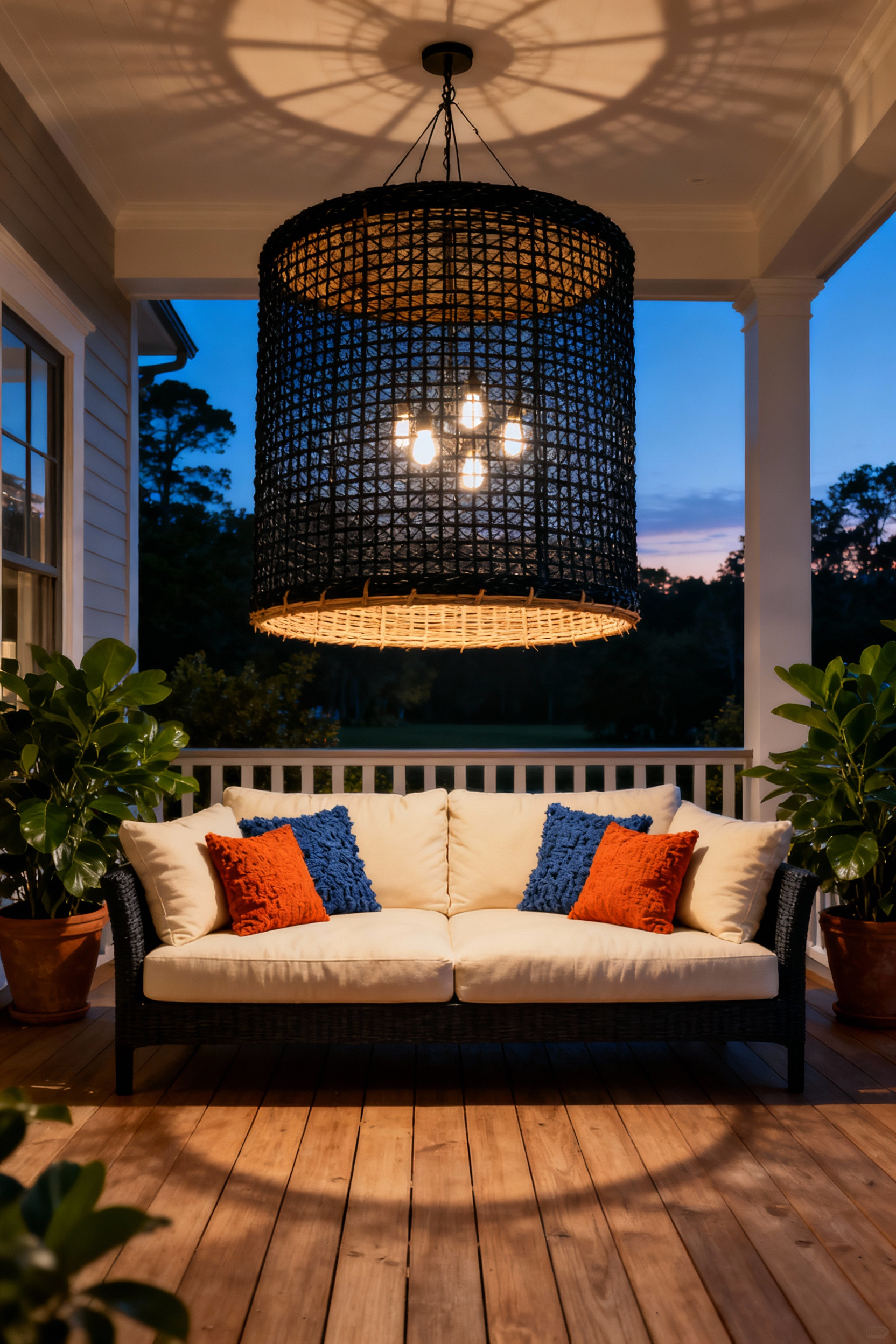
However, true luxury requires durability. In my design practice, I adhere to specific criteria to ensure these statement pieces age gracefully:
- Verify the Rating: Ensure the fixture carries a Damp or Wet location rating to resist rust, moisture, and corrosion.
- Install a Dimmer: This crucial component transitions the atmosphere from functional brightness to a soft, curated glow for evening relaxation.
- Position for Intimacy: Suspend the light centrally over the coffee table to lower the visual ceiling and foster a cozy ambiance.
9. Lighting Layering II (The Ambient): Utilizing wall sconces and portable cordless lamps to create a glow that mimics candlelight.
While the chandelier creates drama, ambient lighting establishes the mood, setting the scene long before the first glass of wine is poured. To mimic the romance of candlelight without the mess, rely on indirect illumination that washes walls rather than blinding guests. Install wall sconces that direct light upward and downward, creating a soft, architectural texture that reduces glare. Crucially, pay attention to the bulb specification; I always insist my clients select LEDs in the 2200K–2700K range. Anything cooler than this soft white spectrum shatters the illusion of warmth and feels clinical rather than cozy.

Furthermore, high-end design no longer demands invasive electrical work. In a recent historic renovation where drilling into the stone facade was prohibited, I utilized battery-operated sconces to achieve a permanent aesthetic without a single wire. Layer this vertical glow with portable cordless lamps, placing them on dining tables or side consoles to create movable pools of intimacy. When selecting these portable fixtures, look for three non-negotiable features to ensure they feel luxurious:
- Substantial weight to withstand wind and feel grounded.
- Integrated dimming to transition from dusk to late-night conversation.
- USB-rechargeability for a clean look free of trailing cords.
10. The Conversation Circle: Arranging furniture in opposing pairs to foster intimacy, rejecting the standard ‘lined up against the wall’ layout.
Thoughtful design dictates that furniture must serve the conversation, not just the architecture. In my design practice, I frequently correct layouts where chairs cling to the perimeter, creating a sterile “waiting room” effect. Instead, cultivate genuine intimacy by pulling your seating inward. Float a sofa and a pair of opposing chairs in the center of the porch, positioning them to face one another directly. This intentional isolation creates a private salon within the outdoors, signaling to guests that connection is the priority.

To execute this timeless arrangement effectively, precision is key. Simply floating the furniture is not enough; you must ground the space.
- Anchor the grouping with a substantial coffee table or fire pit to prevent the furniture from looking adrift.
- Limit the distance across the circle to between 7 and 10 feet so guests never need to raise their voices.
Consequently, the porch feels curated rather than accidental. By rejecting the perimeter, you transform a vast deck into an inviting, high-end destination.
11. The Curated Vignette: Styling side tables with coffee table books, sculptural objects, and trays just as one would in a library.
Treat your outdoor side table with the same curatorial eye used in a fine private library. Begin with a substantial tray—rattan or powder-coated metal works best—to define the space and protect the surface beneath. In my years styling luxury showrooms, I found that a high-quality tray instantly transforms scattered items into a cohesive, intentional display. Since humidity swiftly ruins paper, avoid placing precious hardcovers outside unless your porch is fully enclosed. Instead, simulate the architectural height of a book stack using weather-resistant resin faux books or a low, rectangular planter filled with dense succulents.
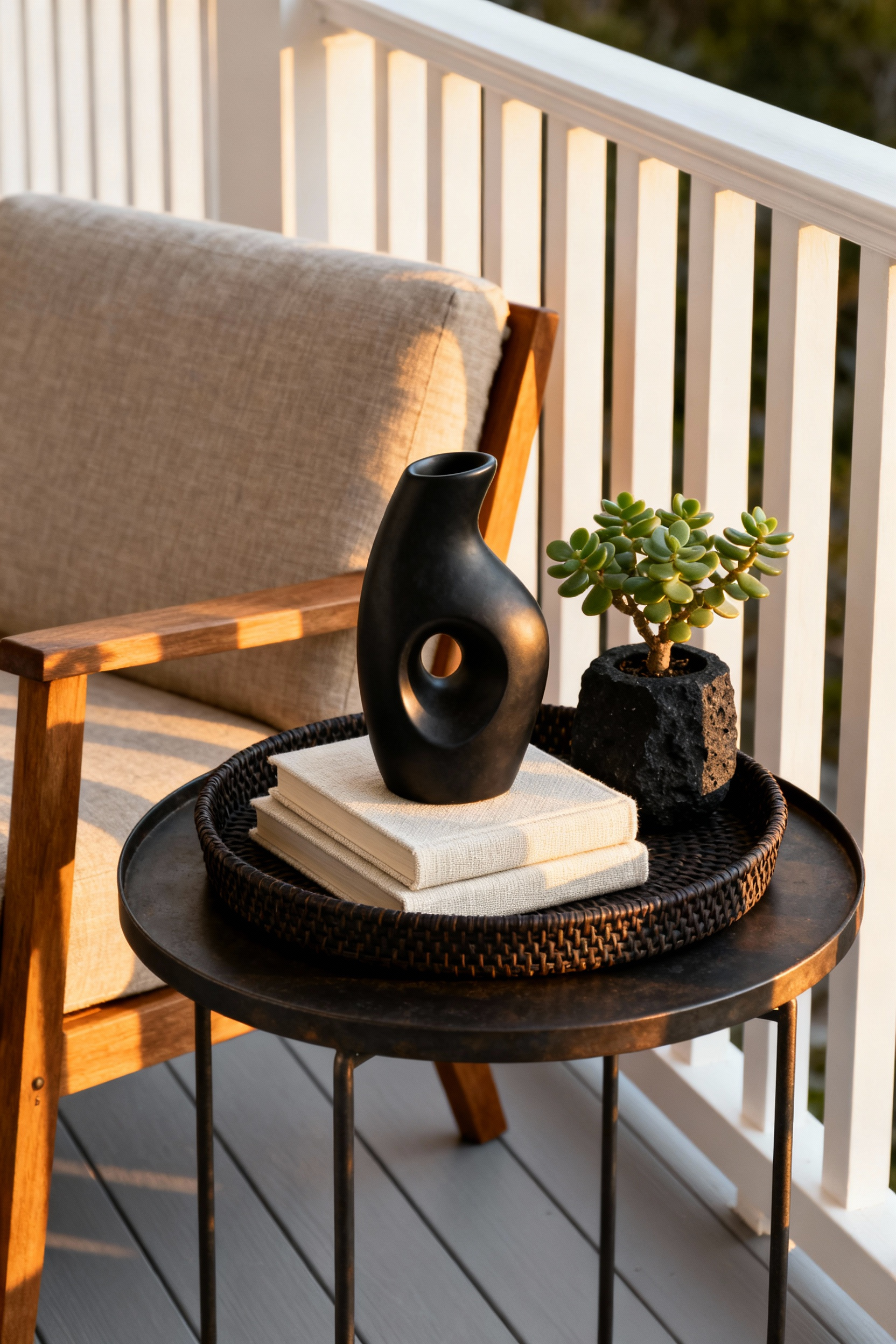
Complete the vignette with a sculptural object designed to withstand the elements. Select durable materials like concrete, unpolished stone, or heavy ceramic to replicate the visual weight of indoor art without the fragility. For a professionally styled aesthetic, adhere strictly to the “Rule of Three”:
- Establish the base with your anchor tray to corral smaller items.
- Build vertical interest using your book alternative or a structured plant.
- Add personality with a geometric stone knot, lantern, or ceramic orb.
This disciplined approach creates a sophisticated narrative that bridges the gap between indoor luxury and outdoor resilience.
IV. Lifestyle Integration: The Sensory Landscape
The final layer of design creates a curated sensory experience. In my years working with discerning clients, I found that the most captivating spaces treat the outdoors with the same reverence as an interior salon. Therefore, stop viewing your porch as a utilitarian exterior and approach it as a tactile destination. Prioritize comfort by investing in deep-seated furniture layered with high-performance, all-weather textiles. A plush outdoor rug and oversized cushions instantly elevate the tactile experience, providing the same invitation to linger as your indoor living room.
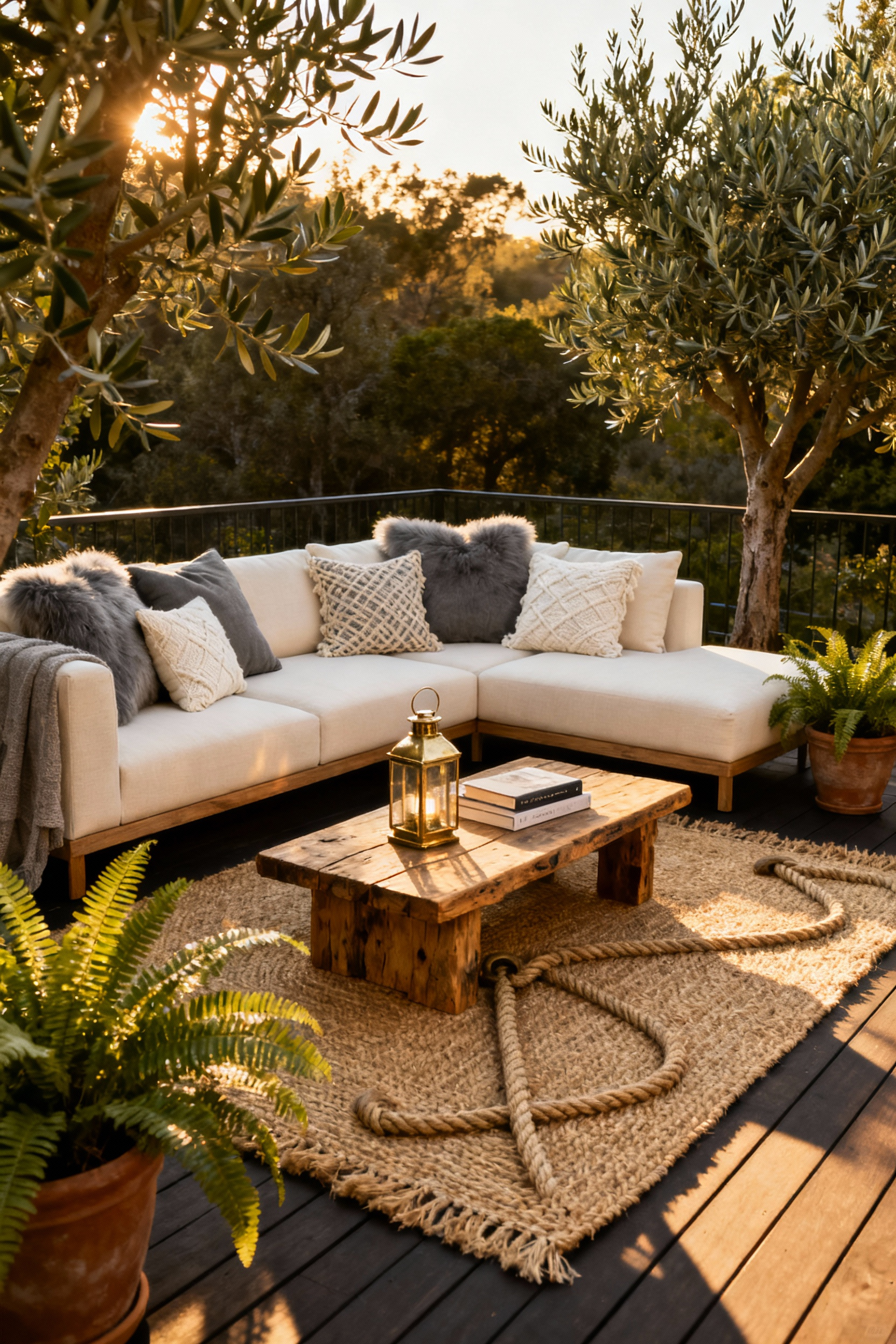
To fully immerse yourself in this sensory landscape, you must deliberately orchestrate the remaining elements.
- Lighting: Banish harsh overhead bulbs. Instead, layer warm-toned string lights or decorative lanterns to create a flattering, cozy glow that extends usability into the evening.
- Sound: Introduce a small water feature or tuned wind chimes. These subtle auditory elements mask urban noise and promote deep relaxation.
- Scent and Taste: Curate an aromatherapy effect by planting aromatic herbs like basil or lavender nearby. This merges fragrance with flavor, engaging the palate while defining the space as a zone for dining or conversation.
12. Sculptural Flora: Using planters as architectural columns rather than mere vessels, selecting specimen trees for dramatic scale.
View large planters as permanent architectural elements rather than temporary decor. In my interior design work, I often utilize weighty cast-stone vessels to flank doorways, creating living columns that ground the porch’s visual weight. Achieve this grandeur by selecting specimen trees with dramatic scale. A ‘Little Gem’ Magnolia offers glossy permanence, while a sculpted Bay Laurel provides formal structure. These choices transform a simple pot into a commanding sentinel.

However, true luxury requires smart engineering. The vessel must be voluminous enough to insulate roots and support the tree for years. To maintain that pristine, high-end aesthetic:
- Sculpt the Form: Train responsive plants like Podocarpus into pyramids or globes to emphasize verticality.
- Commit to Care: Potted trees exhaust nutrients quickly; feed and water them aggressively to prevent a ragged appearance.
- Plan for Winter: Even hardy specimens lose cold tolerance in pots, so position them where they can be sheltered if necessary.
Invest in the health of the specimen, and you secure a timeless design feature.
13. The Auditory Experience: Incorporating water features or hidden acoustic systems to mask neighborhood noise and curate the soundscape.
Design mastery extends beyond the visual; it must command the auditory experience as well. A stunning porch loses its allure if traffic noise dominates the conversation. Therefore, strategically place a multi-tiered water feature near the source of the disturbance. The continuous, rhythmic splashing acts as organic white noise, effectively blurring the sharp edges of neighborhood activity. I recall a specific project where a limestone scupper fountain transformed a noisy city terrace into a private sanctuary, proving that sound is a critical architectural element.

To further curate the atmosphere, layer in concealed technology and sound-absorbing textures. Hard surfaces amplify echoes, so mitigate reverberation with dense outdoor rugs and heavy drapery. Additionally, install waterproof acoustic systems discreetly behind large planters or under railings. This approach offers two distinct benefits:
- Active Masking: You can overlay low-level ambient music to fill silence and smooth out intermittent distractions.
- Visual Clarity: The technology remains invisible, preserving the refined design aesthetic.
By controlling what you hear, you elevate the porch from a simple outdoor space to a sophisticated extension of the home.
14. Thermal Luxury: Integrating flush-mount heaters or heated furniture elements to extend the porch’s seasonality into late autumn.
The best technology is invisible. In my experience designing high-end terraces, clients consistently request warmth that preserves their carefully curated views. Consequently, flush-mount electric heaters have become the gold standard. Recess these infrared units directly into your porch ceiling to achieve an architectural solution that eliminates the visual clutter of freestanding propane towers. However, precise installation remains critical. Engage a licensed contractor to hardwire these units and calculate the necessary wattage for your specific square footage, ensuring complete coverage for your late autumn gatherings.
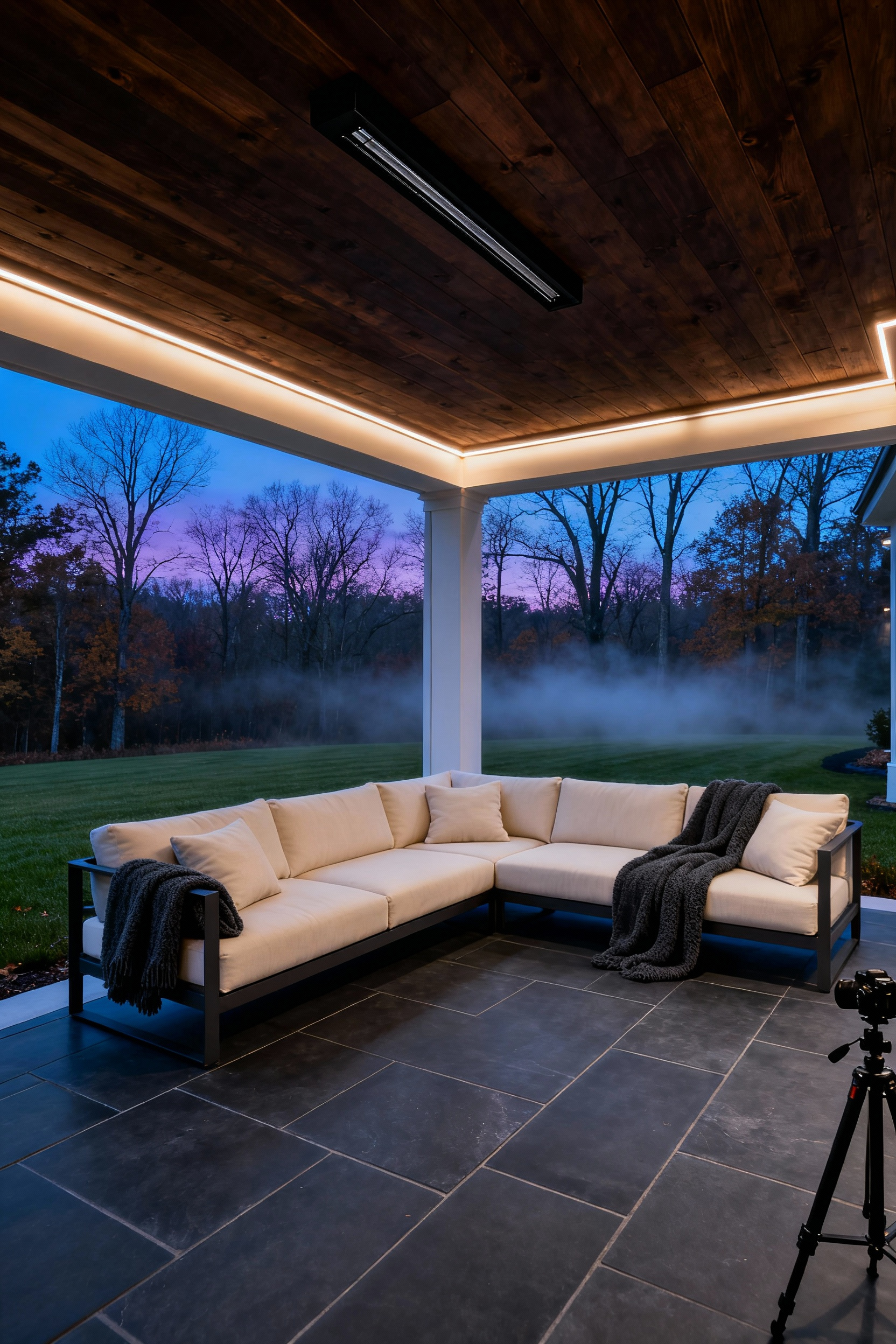
For a more intimate approach, invest in heated furniture. Unlike overhead units, these pieces utilize radiant heating elements to warm the body directly on contact, much like sitting in the sun. This method proves highly efficient, often consuming less power than a hairdryer. When sourcing these investment pieces, I always direct clients toward models with specific smart features to maximize utility:
- Occupant sensors that automatically cut power when the seat is empty.
- Rechargeable battery packs for a cord-free, clean aesthetic.
- Variable controls to adjust heat seamlessly from 80°F to 120°F.
By layering these technologies, you effectively transform a seasonal porch into a permanent, comfortable extension of your home.
15. The Culinary Extension: Designing a sophisticated beverage center or bar cart that rivals the interior wet bar.
Design the outdoor beverage station as a legitimate architectural feature rather than a temporary afterthought. Permanence defines luxury, so prioritize materials that carry visual weight and mimic indoor solidity. Select granite or concrete for fixed countertops, or invest in heavy-gauge teak and marine-grade stainless steel for mobile units. In my experience sourcing for high-end retail, I frequently observed that open shelving invites visual chaos. Consequently, opt for a weatherproof console with closed cabinetry. This conceals supplies, creates a tailored profile, and effectively establishes a sophisticated dry bar.

Seamless functionality distinguishes a refined center from a simple table. Integrate a dedicated outdoor-rated mini-fridge or a built-in drop-in ice bucket to replicate the convenience of an interior wet bar. Once the structure is set, curate your accessories with ruthless discipline to elevate the ambiance:
- Ban plastic entirely; display only heavy crystal decanters and glass barware.
- Anchor the arrangement with a mirrored serving tray and fresh greenery.
- Add strategic lighting, such as under-counter LED strips or portable table lamps.
Lighting transforms the station from a utility area into an evening focal point. By prioritizing craftsmanship and authentic materials, you create a culinary extension that feels timeless.
16. Fine Art Al Fresco: Selecting weather-resistant sculptures or wall relief art to elevate the space from ‘deck’ to ‘gallery’.
Finally, elevate the space from a simple deck to a gallery by prioritizing materials that endure the elements without sacrificing beauty. Choose bronze for its ability to develop a rich, protective patina, or select marine-grade stainless steel for a sleek, rust-resistant finish. During my time sourcing for luxury estates, I witnessed too many “outdoor-safe” resin pieces fade within a season; consequently, I always advise clients to invest in the permanence of stone, powder-coated metal, or sealed concrete. Furthermore, master the art of scale. Anchor a seating area with one large-scale statement piece rather than scattering small trinkets, effectively commanding the eye and defining the room.

To achieve a cohesive aesthetic, align the artwork with your home’s architectural lineage while embracing current sculptural trends.
- Modern Estates: Opt for abstract silhouettes or kinetic wind sculptures that add dynamic movement to the landscape.
- Traditional Homes: Select classic forms in cast stone or weathered Corten steel to mirror the natural surroundings.
Regardless of style, display these treasures intentionally. Elevate smaller works on stone plinths to signal their importance, or mount oversized wall reliefs to add texture to vertical surfaces. This deliberate staging shifts the perception of the object from mere garden décor to fine art installation.
Frequently Asked Questions About Back Porch Decorating
How can I make my back porch look expensive and high-end?
To achieve a high-end look in your back porch decorating, focus on layered, tactile elements and permanent architectural solutions. Use substantial, deep-seated furniture with thick performance cushions (like Sunbrella or marine-grade acrylic). Anchor the seating area with an oversized, hand-woven outdoor rug, install structural drapery, and use warm, dimmable ambient lighting (2700K–3000K) rather than harsh utility lights. Finally, introduce sculptural greenery in weighty, permanent planters.
What is the best material for covered back porch flooring?
For covered back porch flooring, the best options blend durability with seamless design. Large-format porcelain or natural stone tiles (such as honed travertine or slate) are excellent choices, especially if you match them to your interior flooring to dissolve the threshold. If you prefer wood, select high-quality composite decking or rot-resistant hardwoods like sealed Western Red Cedar or ipe, ensuring structural longevity and low maintenance.
How should I strategically light a covered back porch for evening ambiance?
Strategic lighting involves layering three types of illumination: ambient, task, and accent. For ambient light, use dimmable wall sconces or recessed LEDs in the ceiling with a warm color temperature (2200K–2700K) to mimic candlelight. Anchor your main seating or dining area with a statement damp-rated chandelier. Supplement with portable, cordless lamps placed on side tables to create intimate, movable pools of light.
Which materials are essential for luxurious, durable outdoor furniture?
True luxury outdoor furniture requires materials that are both comfortable and weather-resistant. The most durable frame materials include heavy-gauge marine-grade stainless steel, powder-coated aluminum, or investment-grade hardwoods like mahogany and teak (which develop a beautiful patina). Crucially, the upholstery must be thick, high-density foam wrapped in solution-dyed acrylic performance fabrics (e.g., Sunbrella or Crypton), ensuring UV resistance and luxurious hand-feel.
Conclusion: The Final Destination – Transforming the back porch from a casual pass-through into the home’s most coveted destination.
Exceptional design lies in intentionality. By redefining your back porch as a distinct room, you elevate it beyond a mere exit route. Establish a clear purpose for the space, then invest in the foundations of comfort. Layer high-performance textiles, ground the arrangement with substantial rugs, and select furniture that rivals your indoor pieces in quality. This shift in perspective turns a casual exterior space into a seamless extension of your home’s interior narrative.
Sophisticated design demands longevity. Extend the usability of your outdoor room through thoughtful climate control and curated lighting. Use architectural heating or ambient illumination to ensure the space remains inviting well past sunset. Finally, infuse the area with character through integrated technology and personal artifacts. These details transform a standard build into a bespoke environment, making the space feel lived-in rather than simply staged.
Ultimately, the back porch decorating you choose should serve as the home’s *pièce de résistance*. It requires the same discerning eye and dedication to craftsmanship as your formal living areas. Embrace these principles to create a retreat that commands attention and encourages lingering. Assess your current layout today and begin the process of curation. Your home’s most coveted destination awaits just beyond the glass.









